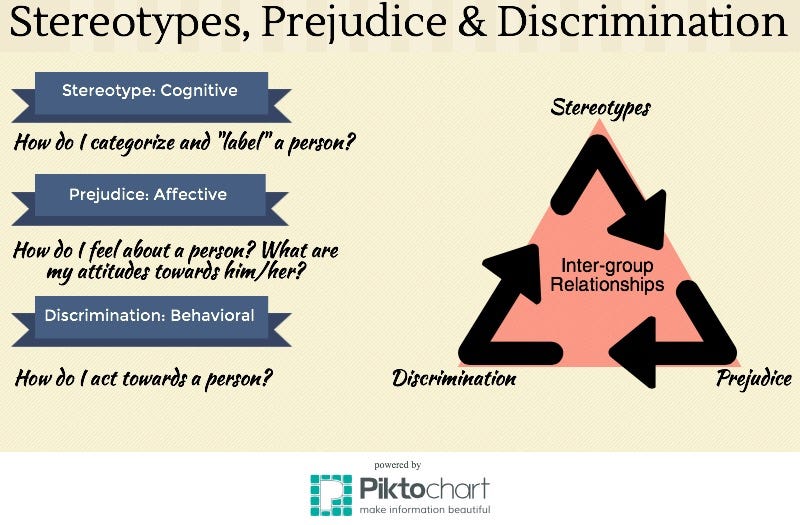Describe the Relationship Between Stereotypes and Prejudice.
A prejudice is not based on experience. Discrimination is an action towards a group.
Chapter 11 Stereotypes Prejudice And Discrimination Principles Of Social Psychology 1st International H5p Edition
Describe the relationship between prejudice and the emotions that.

. Prejudice is a preconceived idea that is not based on actual fact or truth. This unfair attitude is called prejudice. Describe the Influence of Stereotypes Describe the relationship between stereotypes and prejudice.
Prejudice Discrimination and Stereotyping People are often biased against others outside of their own social group showing prejudice emotional bias stereotypes cognitive bias and discrimination behavioral bias. A positive or negative evaluation of another person based on their perceived group membership eg race class or gender. When rating scales are used in the absence of objective measures shifting standards may a.
Provide one example of how a stereotype can lead to prejudice. This paper aims to apply the social psychology research on cognition. Write your response in the space below.
Lets further examine these two concepts. A conventional opinion or image of a group of people or things based on second-hand information. It is only at an attitude level of the other person.
There is a stereotype in Us that people who belong to African American community are drug dealers. Prejudice is unjustifiable and negative attitudes toward an individual or group based on reinforced misinformation about a social group. Stereotype is a widely held but set and oversimplified image or idea about a particular type of person objective or a group of people.
Stereotypes- Women are weak Here the first decision was taken without any meaning. Stereotypes can be positive or negative conscious and unconscious inferences about a social group. 99 describe prejudice as a negative feeling resulting from a negative or false stereotype Prejudice is an emotion and manifests itself.
Help raters avoid the effects. The research that have been conducted on prejudice show that much of prejudice is based on negative feelings. Stereotype is a belief.
Discrimination is linked to stereotypes and prejudice. Prejudice refers to the beliefs thoughts feelings and attitudes someone holds about a group. Prejudice is basically an opinion that is not based on any reason or experience.
Stereotypes arise from having general knowledge about a group while prejudice comes about when we attribute those general characteristics to each of the members of that group. Stereotyping refers to the various assumptions created by people concerning the characteristics of members of a particular cultural group. Everyday social interaction associations and patterns that we see in the world people around you peers family and other social contacts historical perspective stereotypes spring from past events.
Stereotypes are non-scientific over-generalizations about a social group. It also includes prejudice and discrimination against those who are elderly based on the notion that older persons are not as capable as younger people. In general the personality traits were not as consistently or as strongly associated with emotional reactions to these groups as were the evaluative aspects of stereotypes.
Prejudice is an unjustified attitude towards a person due to his membership in a group. This relatively fixed change in perspective is known as bias. Prejudice refers to the judgment made by individuals over past experiences rather than an evaluation of present circumstances.
Both prejudice and stereotype are similar concepts related to beliefs and attitudes we have towards certain people and things. Stereotypes reduce our mental energy expenditure. Prejudice is the affective component that encompasses our feelings about a group.
The relationship between stereotypes prejudice and discrimination in teaching cross-cultural communication in Japan. When were prejudiced we make inferences that facilitate the acceptance or rejection of that group. Instead it is a prejudgment originating outside.
While stereotypes can be positive or negative they are usually perceived as negative. Bias in the workplace Stereotypes prejudice and discrimination create physical and emotional distance between members of different social groups. For example many stereotypes that are currently used to characterize black people were used earlier in American history to characterize Irish and Eastern European immigrants.
A person having an attitude that white people are superior. Stereotypes that suggest that women are superior to men in many ways and that women are necessary for mens happiness are a major part. Prejudice consists of feelings or attitudes discrimination consist of behavior Where do stereotypes come from.
Both prejudice and stereotypes are often not based in reason or personal experience but they shape the way that we see the world. The chicken has an undeserved negative attitude towards the cat and mentally grumbles at its customer. For this reason prejudice refers to beliefs without sound knowledge of the facts concerned with the belief.
Prejudice is an attitude. Stereotypes represent the cognitive component and are composed of our beliefs about a particular social group. A network model of cognition and affect is used to interpret the findings of this and related studies and to address their implications for changing prejudice.
Stereotypes are untrue assumptions made about groups of people. For example stereotypes about the elderly are that they have poor memories cannot learn new things and are not interested in sex. At this point its important to notice that the chicken does not display an obvious action towards the cat yet.
It is a conception of people based on ethnicity race gender caste and the like. Discrimination is the behavioral component of attitudes and includes the different actions directed towards members of different groups. Strong egalitarian social norms however might deter a prejudiced person from acting in a discriminatory manner.
This is primarily the difference between stereotype and prejudice. Stereotype means an oversimplified idea of the typical characteristics of any object or person Prejudice- Until the early years of the twentieth century women were not allowed to vote. If left unchecked prejudices and stereotypes can lead to discrimination and violence.

Stereotypes Prejudice And Discrimination A Primer By Aparajita Jeedigunta Medium


No comments for "Describe the Relationship Between Stereotypes and Prejudice."
Post a Comment